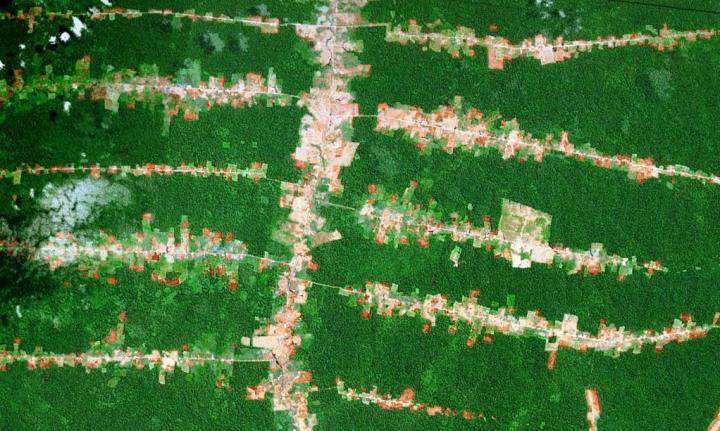
CREDIT
Google Earth
Our world is being developed at an unprecedented pace, and the incredible expansion of infrastructure associated with all of this progress comes at a great cost to wild places and wildlife.
Now, a team of scientists writing in the Cell Press journal Current Biology on March 5 call attention to nine issues that must be considered if there is to be any hope of limiting the environmental impacts of the ongoing expansion of new roads, road improvements, energy projects, and more now underway or “coming soon” in countries all around the world.
“We are living in the most explosive era of infrastructure expansion in human history,” write William Laurance of Australia’s James Cook University and his colleagues. “By mid-century, it is expected that there will be 25 million kilometers of new paved roads globally–enough to encircle the Earth more than 600 times. Nine-tenths of these new roads will be in developing nations, which sustain many of the planet’s most biologically rich and environmentally important ecosystems.”
The new paper is the foundation for a major effort by scientists, environmental activists, and celebrities to lobby leaders of the G20 nations–the 20 wealthiest nations on Earth–following their announcement of plans to invest $60-$70 trillion US dollars in new infrastructure globally by 2030. The plan would more than double the global investment in new roads, dams, power lines, gas lines, and other energy infrastructure.
“Unless managed with extreme care, it would be an environmental disaster wrapped in a catastrophe,” Laurance says of the proposal.
“This research is a seminal effort, and it’s going to have a huge impact in policy circles,” says Randy Hayes, Director of Foundation Earth in Washington, D.C. “The fight for a better world will not be easy, but this analysis gives us concrete actions and strategies for reducing the impacts of this global tsunami of new infrastructure.”
Hayes and his associates plan to release a statement to G20 leaders on March 6, the day after the paper by Laurance and colleagues is published online.
The researchers emphasize that the threat to wild places is even more serious when illegal development activities are considered in addition to those that are officially sanctioned. In the Brazilian Amazon, for instance, there are three times more illegal roads than there are legal roads.
“Roads that penetrate into wilderness areas often have particularly serious effects, often opening a Pandora’s Box of environmental problems–such as promoting habitat conversion and fragmentation, poaching, illegal mining, wildfires, and land speculation,” the researchers say.
Projects such as hydroelectric dams and mines come with their own inherent problems, and they typically also bring with them more new roads or road upgrades, both of which present challenges to wildlife. Laurance and his colleagues from the Netherlands, the United Kingdom, and the United States raise nine points for addressing these challenges:
Read more: Nine steps to survive ‘most explosive era of infrastructure expansion in human history’
The Latest on: Human infrastructure expansion
[google_news title=”” keyword=”Human infrastructure expansion” num_posts=”10″ blurb_length=”0″ show_thumb=”left”]
via Google News
The Latest on: Human infrastructure expansion
- Kuruleca affirms commitment to ECEon April 28, 2024 at 11:29 am
Permanent Secretary for Education Selina Kuruleca is committed to early intervention in Early Childhood Care and Education (ECCE). This was reiterated during a recent meeting with the Regional ...
- ClearBridge Global Value Improvers Strategy Q1 2024 Commentaryon April 28, 2024 at 8:40 am
The ClearBridge Global Value Improvers Strategy outperformed its MSCI World Value Index benchmark during Q1 2024. Click here to read the full fund letter.
- Report highlights human rights progress and pitfallson April 26, 2024 at 10:52 pm
Fiji’s human rights situation outlined in the 2023 US Department of State report reveals progress and ongoing challenges. The report notes that the Coalition Government has made efforts to address ...
- How EOR Services Can Help Your Business Expand Internationallyon April 26, 2024 at 1:26 am
Considering expanding your business internationally? Imagine having a seamless payroll system in place, staying compli ...
- From COVID-19 to national cultural policy: Understanding the importance of cultural infrastructureon April 25, 2024 at 7:31 pm
The increased use of the term “cultural infrastructure” allows us to identify and account for the value of culture in more expansive ways: it lets us see what is often taken for granted as an inherent ...
- Cuba Will Pursue China Ties 'to Maximum Extent' But Rules Out Military Baseon April 25, 2024 at 10:34 am
"We don't know of any hostile act against the U.S. by China in the region," Deputy Foreign Minister de Cossío tells Newsweek.
- Alabama lawmakers weigh Medicaid expansion approaches in Southern stateson April 25, 2024 at 5:01 am
The Alabama House and Senate committees on health held a joint session Wednesday to learn more about Medicaid expansion in two southern states. The meeting focused on Arkansas, which expanded Medicaid ...
- White House unveils plan to accelerate power grid expansionon April 25, 2024 at 3:24 am
DOE created a one-stop shop for permitting, helping transmission developers avoid the regulatory patchwork that has tripped up projects.
- DISNEYLAND UPDATE: Exciting Expansion, Pixar Surprise & Electric Tomorrow!on April 21, 2024 at 11:00 pm
This past week marked a major milestone in Disneyland history — Anaheim approved(ish) a nearly $2 billion expansion of the Disneyland Resort. The future of the resort is filled with possibilities, and ...
- Human-elephant conflict: The way outon April 19, 2024 at 6:27 pm
To ensure the protection of these majestic creatures, it is imperative to revisit and revise legislative frameworks with a focus on ecological sustainability India’s rich biodiversity includes a ...
via Bing News









